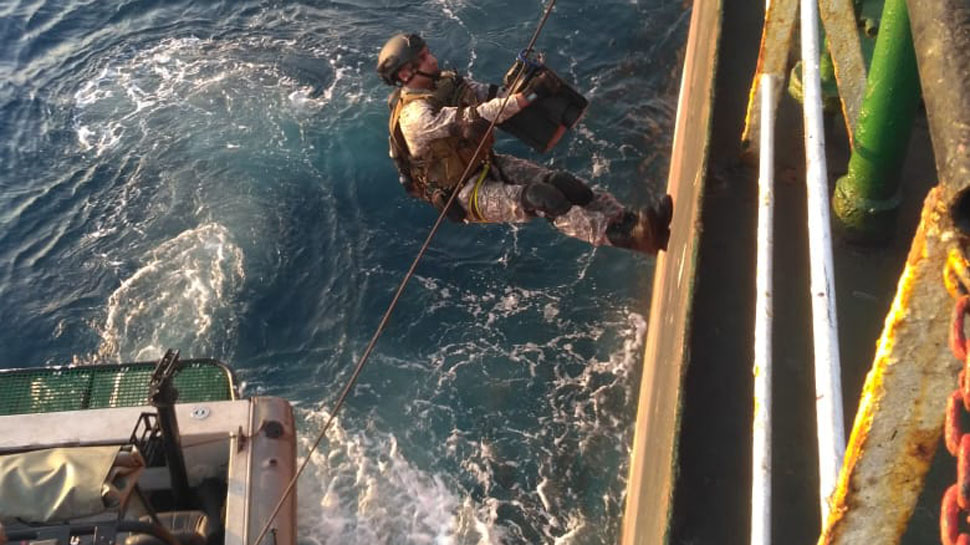
Exercise Sea Vigil, India’s largest-ever Coastal Defence Exercise was conducted over an intense 36-hour period from 22-23 Jan 19. Exercise Sea – Vigil conceptualised and led by the Indian Navy and Coast Guard saw the simultaneous activation of India’s entire Coastal Security apparatus across all nine Coastal States and four Union Territories. The exercise saw the complete support and earnest participation of all Central and State agencies including the MHA, MoD, Customs, CISF, Dept of Fisheries, DGLL, DG Shipping, Port authorities and the Coastal police of all participating states.
Planned in two phases, the Phase I commenced with the deployment of personnel and sea-going units of all stakeholders. 150 ships and 35 aircraft of the Navy and Coast Guard were deployed for the exercise. This when added to sea-going assets of other stakeholders like the State police, CISF, Customs etc reaches an astonishing 500-600 craft at sea. This layered defence provided a near-unbroken ‘Nigrani’ or surveillance net along the entire coast of India and outlying islands. This was further enhanced by the Chain of radar stations setup along the coast as part of the Coastal surveillance network. All this was fed back to the Joint Operations Centres set up by the Navy at Mumbai, Kochi, Visakhapatnam and Port Blair for monitoring, analysis and response.
The uniform and technical surveillance network was further augmented by the fishing communities along the coast as the ‘eyes and ears’ of the nation’s coastal security construct. The Phase I also saw an intensive audit of all measures put in place since 26/11 to improve the measures of efficiency and effectiveness of coastal security. This ‘Nireekshan’ was undertaken by multi-agency teams deployed to check and audit important landing points including Fish Landing Centres and Vulnerable areas and important installations along the coast as well as in the hinterland.
The entire coastal security apparatus was thereafter shifted to Phase II commencing 8 pm on 22 Jan 19. This Phase saw attempts to penetrate and land dummy explosives by designated ‘RED’ forces comprising teams drawn from the Navy Coast Guard, Police and CISF. These teams were given a free hand to commandeer fishing vessels, merchantmen etc and attempt to reach the coast. 8-10 teams were deployed in each state and it is to the credit of all participating agencies that only a few ‘attacks’ were successful. Many attacks were allowed to ‘go-through’ to test robustness of Police ‘Nakabandi’ which was found to be very effective throughout the exercise. The Customs also undertook rummaging of visiting ships at anchorage and in harbour.
Driven by the MHA, the Phase II also saw the exercising of various contingencies on land after an ‘assumed’ landing. The NSG was also called in to tackle hostage situations in two-three vital installations. Contingencies including hijacking of ships, bomb disposal in malls, attacks and responses on places of worship etc were also exercised and tested for effectiveness. The Crisis Management Groups of states were also activated to deal with such situations.
The Navy, made responsible for overall maritime security including coastal and offshore security since 26/11, will now conduct a detailed debrief for all stakeholders in Mar 19. Debriefs would also be undertaken with all participants at the State and District levels. The feedback of the internal and external audit and lessons identified are planned to be presented at the next meeting of the National Committee for Strengthening Maritime and Coastal Security (NCSMCS), the nation’s highest body that monitors implementation of measures to enhance security post 26/11. This is expected to allow stakeholders to focus efforts on identified vulnerabilities and lacunae. No coast can be completely sealed at all times, however the ability to deter and prevent enemies of the state from unhindered access to land would continue to remain top priority for all stakeholders in the Coastal Security construct. The ability to quickly respond to successful intrusions and diffuse situations in quick time and minimum casualties to people/ infrastructure would also be paramount for the security of the citizens and India.
The ready acceptance of all stakeholders to be a part of the Exercise Sea Vigil and their whole-hearted cooperation and extensive participation indicates high levels of synergy and coordination through a whole-of-government approach of the current government towards national security. This first-ever large scale Coastal Defence Exercise would be now institutionalised to be conducted every two years in addition to the state-focussed Sagar Kavach series of exercises. Sea Vigil 2019 saw the largest mobilisation of maritime and coastal security machinery in India and this sends an unambiguous message to Anti-National Elements that India would spare no effort to defend it’s coast and territorial integrity at all times.







Leave a Reply
You must be logged in to post a comment.